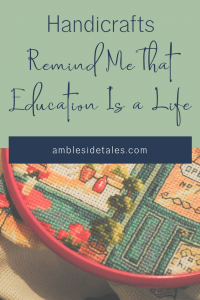
This post contains affiliate links. For more information, please see my Disclaimer.
I knew roughly what I was getting into when we decided to pursue a Charlotte Mason homeschool program for our son. At least, I knew intellectually. But to be honest, I’m not sure I really considered handicrafts. I do see the humor in the fact that handicrafts are reminding this Charlotte Mason homeschool mom that education is a life. I guess it’s now or never to learn to sew! Is it time to panic? 🙂
For the last week, I have been experiencing Mason’s motto in new ways. I feel off when our atmosphere is cluttered and rushed. I’m practicing the discipline required for regular lesson planning. And thanks to handicrafts, I’m living the reality that education is a life.
Handicrafts Aren’t Easy
Handicrafts are not my forte. At the Form 1B level, I can do the basic subjects, Spanish, music, and even a little art. But our attempt at paper Sloyd, while not bad for a first effort, made me realize that this subject will be a challenge. Similarly, our first sewing lesson proved that our products won’t be worthy of a craft fair for a while (or maybe ever!).
Despite this, what do you think our son told his dad was his favorite part of the day? Of course, handicrafts! I want to see him enjoy and succeed at this, so I press on and use my own limited skills to help spread the feast before him.
The challenge with doing a precision craft with a 6-year-old is coordination. For paper Sloyd, how do you hold the ruler and draw a line at the same time? How do you make sure that your line is exactly 6 inches from the edge of the paper? How do you cut a perfectly straight line?
For sewing, how do you sew a straight running stitch? How do you cut the lines to match the pattern perfectly? How do you not unthread your needle with every other stitch? And for goodness sake, how do you produce a product that doesn’t look childish?
Well, you don’t right away. The truth is a 6-year-old may not be able to perform these requirements perfectly. And this means that the project you’re doing will be less than perfect. But that’s where the discipline enters. These skills won’t develop overnight. After all, they are a craft. So, we’ll try the project again next week and perhaps do some paper cutting practice this week during quiet time.
Handicrafts Are More Than Entertainment
Mason’s description of handicrafts suitable for children under 9 insists that they not be futile activities simply designed to entertain them (vol 1, p. 315–316). I’m sure he would rather enjoy gluing cotton balls onto a paper to make clouds, but that’s not handicrafts. Rather this should be real work that children are taught slowly and carefully over time. The should also learn that sloppy work is not acceptable.
Sloppy work and lacking skill are not synonymous. I’m pretty sure that before it’s all said and done, we will have quite a few less than perfect paper envelopes and miniature pillows around our house. But the goal is for him to be getting better at measuring, marking lines, cutting and folding with precision, and stitching evenly. I can’t expect this within the next few weeks, but I have confidence that he will get better over time.
And then there’s my own skill level. For years, I’ve passed my mending to my mom. She used to sew clothes when I was a baby, so she’s the real deal. I tease her that if she had taught me to sew she could have saved herself all this work over the years. She likes to remind me that she didn’t teach me because I was left-handed and that made everything backward.
Handicrafts Are Helping Me Learn A New Skill
Well, thanks to handicrafts, I can continue my own education. I may have finished my formal schooling, but that doesn’t mean that I’m done learning. This is a great opportunity for me to show our son that Mom is still learning too. I’ll likely never be a professional seamstress, but I should be able to have a basic mastery of the craft of sewing (or at least mend a few seams).
Another point of encouragement for me regarding handicrafts is that we’re starting at the beginning. We haven’t missed out on important foundational skills, so we will have the benefit of improving our abilities and finding crafts that we enjoy and that could perhaps be a means of creating beautiful and useful items.
Beyond the motor skill development, appreciation for a skill, and opportunity to create, handicrafts remind this Mason homeschool mom to keep learning. Perhaps I should warn our family members that they may be receiving many crafty creations in the coming years.
Are you doing handicrafts as part of your homeschool? What’s your favorite type of craft? Be sure to enter your email and join the Ambleside Tales community where you can participate in the conversation with other Mason homeschoolers.
[…] Handicrafts continue to be a challenge. I didn’t realize how limited my son’s scissor skills were until we tried to do paper Sloyd. This makes sense–he didn’t attend preschool or Kindergarten where they’re always cutting out some art project. His inability to cut along a straight line made Sloyd frustrating for him and me. I’m brainstorming options to replace Sloyd. […]